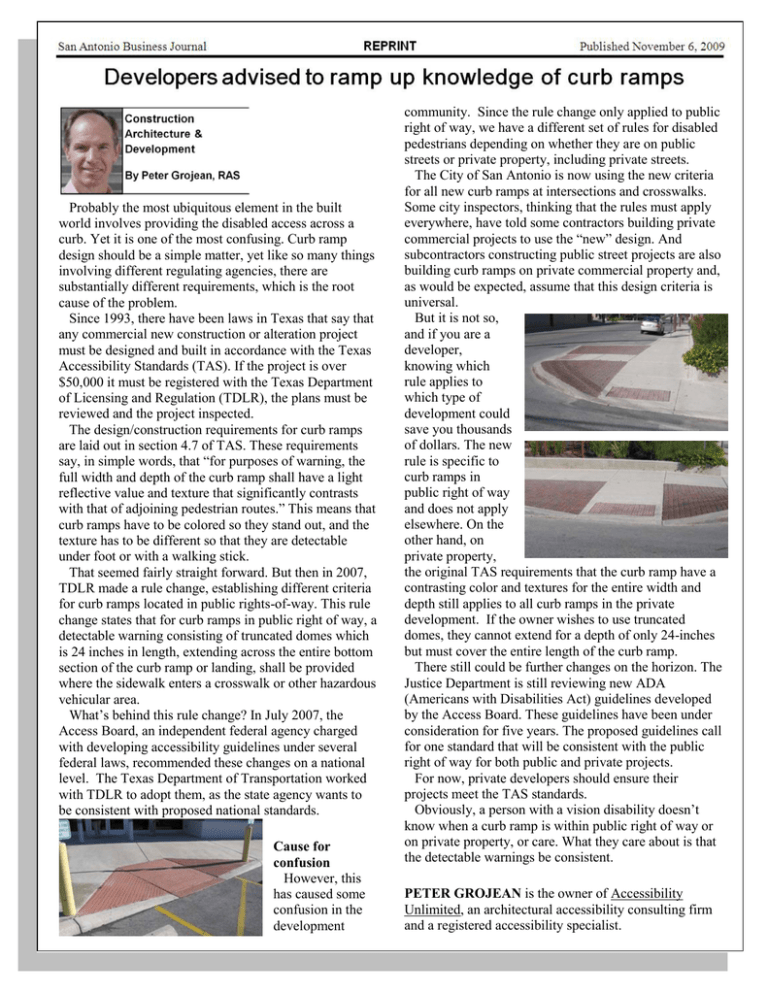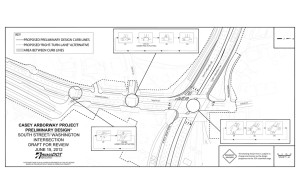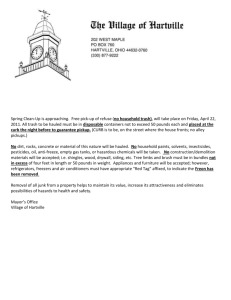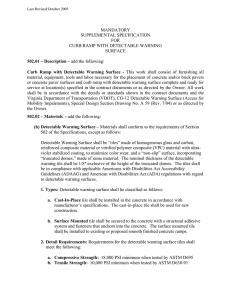Developers Advised to Ramp Up Knowledge of Curb Ramps
advertisement

Probably the most ubiquitous element in the built world involves providing the disabled access across a curb. Yet it is one of the most confusing. Curb ramp design should be a simple matter, yet like so many things involving different regulating agencies, there are substantially different requirements, which is the root cause of the problem. Since 1993, there have been laws in Texas that say that any commercial new construction or alteration project must be designed and built in accordance with the Texas Accessibility Standards (TAS). If the project is over $50,000 it must be registered with the Texas Department of Licensing and Regulation (TDLR), the plans must be reviewed and the project inspected. The design/construction requirements for curb ramps are laid out in section 4.7 of TAS. These requirements say, in simple words, that “for purposes of warning, the full width and depth of the curb ramp shall have a light reflective value and texture that significantly contrasts with that of adjoining pedestrian routes.” This means that curb ramps have to be colored so they stand out, and the texture has to be different so that they are detectable under foot or with a walking stick. That seemed fairly straight forward. But then in 2007, TDLR made a rule change, establishing different criteria for curb ramps located in public rights-of-way. This rule change states that for curb ramps in public right of way, a detectable warning consisting of truncated domes which is 24 inches in length, extending across the entire bottom section of the curb ramp or landing, shall be provided where the sidewalk enters a crosswalk or other hazardous vehicular area. What’s behind this rule change? In July 2007, the Access Board, an independent federal agency charged with developing accessibility guidelines under several federal laws, recommended these changes on a national level. The Texas Department of Transportation worked with TDLR to adopt them, as the state agency wants to be consistent with proposed national standards. Cause for confusion However, this has caused some confusion in the development community. Since the rule change only applied to public right of way, we have a different set of rules for disabled pedestrians depending on whether they are on public streets or private property, including private streets. The City of San Antonio is now using the new criteria for all new curb ramps at intersections and crosswalks. Some city inspectors, thinking that the rules must apply everywhere, have told some contractors building private commercial projects to use the “new” design. And subcontractors constructing public street projects are also building curb ramps on private commercial property and, as would be expected, assume that this design criteria is universal. But it is not so, and if you are a developer, knowing which rule applies to which type of development could save you thousands of dollars. The new rule is specific to curb ramps in public right of way and does not apply elsewhere. On the other hand, on private property, the original TAS requirements that the curb ramp have a contrasting color and textures for the entire width and depth still applies to all curb ramps in the private development. If the owner wishes to use truncated domes, they cannot extend for a depth of only 24-inches but must cover the entire length of the curb ramp. There still could be further changes on the horizon. The Justice Department is still reviewing new ADA (Americans with Disabilities Act) guidelines developed by the Access Board. These guidelines have been under consideration for five years. The proposed guidelines call for one standard that will be consistent with the public right of way for both public and private projects. For now, private developers should ensure their projects meet the TAS standards. Obviously, a person with a vision disability doesn’t know when a curb ramp is within public right of way or on private property, or care. What they care about is that the detectable warnings be consistent. PETER GROJEAN is the owner of Accessibility Unlimited, an architectural accessibility consulting firm and a registered accessibility specialist.






